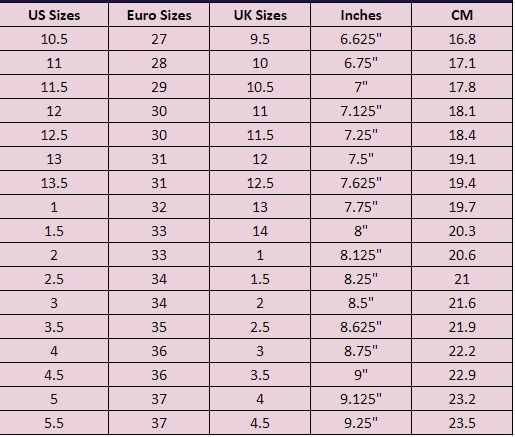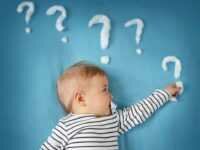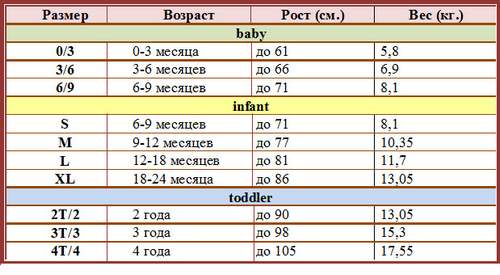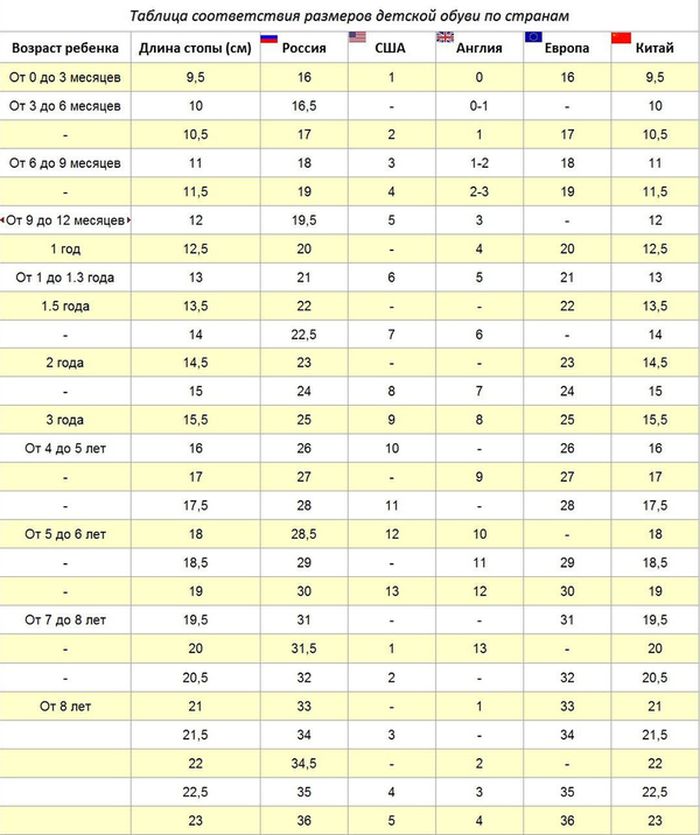From toddler size (based on Russian measurements) to school age.

- children's foot sizes
- Measure your feet correctly.
- How to choose the right size for children's shoes in Moscow?
- How to find the right size of children's shoes?
- Adaptation of Russian sizes to foot length
- How to determine your child's shoe size
- 3 steps to correctly measure your child's foot
- How often should children's feet be measured?
- Children's tights and nightwear
- Sizes of children's shoes, socks and stockings
- Measure the length of your child's foot
- How much space should I leave in front of my toes?
- Different ways to measure foot length in centimeters
- Accepted shoe sizes in Russia depending on age
- American sizes for children's clothing
- The best way to find the right size is to measure your baby.
- Children's shoe size table by country of manufacture and popular brands
- Children's shoe sizes by brand
children's foot sizes
Depending on the region, we will show you the current delivery times and availability in stores in your city.
| feet (cm) | shoe size |
| 9,5 | 16 |
| 10,5 | 17 |
| 11 | 18 |
| 11,5 | 19 |
| 12,5 | 20 |
| 13 | 21 |
| 13,5 | 22 |
| 14,5 | 23 |
| 15 | 24 |
| 15,5 | 25 |
| 16,5 | 26 |
| 17 | 27 |
| 17,5 | 28 |
| 18,5 | 29 |
| 19 | 30 |
| 19,5 | 31 |
| feet (cm) | shoe size |
| 20,5 | 32 |
| 21 | 33 |
| 21,5 | 34 |
| 22,5 | 35 |
| 23 | 36 |
| 23,5 | 37 |
| 24,5 | 38 |
| 25 | 39 |
| 25,5 | 40 |
| 26,5 | 41 |
| 27 | 42 |
| 27,5 | 43 |
| 28,5 | 44 |
| 29 | 45 |
| 29,5 | 46 |
Measure your feet correctly.
Place a sheet of paper on a hard, stable surface. Ask your child to stand on this piece of paper. Make sure the toes are not pinched and the distance between the feet is at least 10 cm (the width of a foot).
Hold the pencil vertically and trace both feet.
In the finished outline, draw a straight line from the tip of the big toe to the middle of the heel. This should be done for both feet.
Measure the length of the resulting line on both feet. Then take the larger number for the calculation.
Consult the size chart and choose the right size based on the length of your feet.
How to choose the right size for children's shoes in Moscow?
Searching, finding, trying on and buying shoes in stores is not a happy time in a child's life! When you go shopping or order shoes from an online children's shoe store, you can easily determine your child's shoe size.
- It is best to measure at the end of the day when foot size is at its largest - at the end of the day blood rushes to the feet and foot size increases.
- Before taking the measurement, put your child in the socks they are likely to wear their new shoes in. The thickness of the socks, especially the use of thick wool socks, has a noticeable effect on the size of the shoes you need.
- It is better to measure both feet and aim for a larger measurement.
- It is better to measure in centimeters, since metric shoe sizing systems very often use this system of measurement.
- When choosing a size, we recommend rounding the result up to the size received, as doctors recommend that children aged 2-3 years should change to larger shoes at least once a year, and children aged 3-6 years at least twice a year and every time one size larger.
- It is important to remember that the system of measurements and sizes in Russian and European shoes is completely different. Russian shoes are guided by the seam system, where 1 size = 6.6 mm.
The size difference in European shoes is up to 5 mm.
Many manufacturers use the metric system to identify their makes and models of children's shoes.
How to find the right size of children's shoes?
1 Place the child on a piece of paper on a flat surface. The child should stand on the sheet or at least sit with their foot on the ground. Otherwise, you may end up resizing down, which is highly undesirable.
Adaptation of Russian sizes to foot length
As a child grows and matures, parents are continually faced with the need to determine the size of their child's feet. Whether it's shopping or ordering online, it's better to know the shoe size beforehand. There are special tables that help to determine this. These dimensions are universal for Russian manufacturers.
| foot length, cm | Size | Foot length, cm | Size |
| 9,5 | 16 | 17 | 27 |
| 10 | 16,5 | 17,5 | 28 |
| 10,5 | 17 | 18 | 28,5 |
| 11 | 18 | 18,5 | 29 |
| 11,5 | 19 | 19 | 30 |
| 12 | 19,5 | 19,5 | 31 |
| 12,5 | 20 | 20 | 31,5 |
| 13 | 21 | 20,5 | 32 |
| 13,5 | 22 | 21 | 33 |
| 14 | 22,5 | 21,5 | 34 |
| 14,5 | 23 | 22 | 34,5 |
| 15 | 24 | 22,5 | 35 |
| 15,5 | 25 | 23 | 36 |
| 16 | 25,5 | 23,5 | 37 |
| 16,5 | 26 |
How to determine your child's shoe size

Here's an easy way to measure your child's feet. There is a simple procedure that allows you to easily find out the height for a confident child:
- You will need a piece of paper, a ruler and a pencil.
- Place your child's feet on the sheet to trace the outline of the foot. The child should lean on the foot to be measured.
- Use the ruler to measure the distance from the center of your heel to the tip of your longest toe.
- Do the same with the other foot. It is important not to overlook this point, as the size of one foot can differ from the other by up to 0.5 cm. In this case, select the largest value.
- Use the manufacturer's size chart to determine the correct size based on the measurements found.
This method allows you to determine the size of children's shoes by the length of the foot. Fortunately, this is not the only method. There is another method where the size can be determined by the insole of the child's shoe. This approach does not use a table. In our country, children's shoe sizes are not measured in centimeters. For this purpose, the gauge system is used, in which not a centimeter but a gauge m, which corresponds to 2/3 of a centimeter, is used as the unit. First you take the value of the foot length and add 1 cm to get the insole length. Then divide the result by 2 and multiply by 3. That's the size you're looking for.
For example, a child's foot is 13 cm long. Let's do the calculations: (13+1)/2*3=21. The required size for a 13 cm foot - 21. Check with the chart, everything is correct. How to determine the correct shoe size for your child.
If the child is not walking, the foot is measured with a ruler while lying down. The result can be rounded up.
Nowadays there are special measuring tapes that make it easier for parents to find the right size.
3 steps to correctly measure your child's foot

To determine your child's shoe size, you should follow a few tips. These will help you accurately measure the length of your child's feet so you can make a mistake-free purchase of a new pair of shoes.
1. The shoe should be measured while standing. Place a sheet of white paper or card under both feet. Trace the contours of the feet with a pencil. Alternatively, you can also measure with wet footprints. To do this, dip both feet in water and immediately make imprints on the paper.
Tip! Younger children's feet can be measured with a tape measure. A piece of string that can be placed on a ruler after measuring also works well.
2 Measure the length of the footprints. It is measured from the big toe to the heel. The length is measured on both footprints, then added together and divided in half. This is how the arithmetic mean is calculated.
Danger!!! The length of one foot may be slightly longer than the other. Therefore, the above tips are very important for a correct calculation. When choosing the shoe size, you should use the larger foot size as a guide.
3. When choosing summer shoes, add 0.5 cm to the calculated foot size. This is necessary because. In hot weather, children's feet can swell and there should be more room in the socks. When choosing winter shoes, add 1.5 cm to the measured foot size. Winter boots should have room for a warm sock and air space to keep you warm. Never choose shoes that are fitted to the foot.
How often should children's feet be measured?

Children's tights and nightwear
The size of children's tights is determined based on height, chest circumference and foot circumference in centimetres. So, for example, tights size 74, 48, 12 can be bought for a child from one to one and a half years old, if the child's height is at least 74 cm. If a child with a height of 74 cm is rather chubby, then it is better to buy tights of a larger size, that is, 80-86.
| Old | Pantyhose Sizes | Sizes for zippers | ||
|---|---|---|---|---|
| foot length and chest circumference | Sizes according to height | Europe | Russia | |
| 3-6 months | 9/40-44 | 62-68 | 20 | 40 |
| 6-12 months | 9-10/40-44 | 68-74 | 22 | 44 |
| 1-1.5 years | 11-12/48 | 74-80 | 24 | 48 |
| 1.5-2 years | 12-13/48-52 | 80-86 | 26 | 52 |
| 2-2.5 years | 13-14/52 | 86-92 | ||
| 2.5-3 years | 14-15/52-56 | 92-98 | ||
| 3-4 years | 15-16/56 | 98-104 | ||
| 4-5 years | 16-17/56 | 104-110 | ||
| 5-6 years | 17-18/56-60 | 110-116 | ||
| 6-7 years | 18-19/60 | 116-122 | ||
Sizes of children's shoes, socks and stockings
In Russia, the metric system is used, where a child's shoe size is the length of the foot (from the most protruding heel to the most protruding toe) in millimeters.
Generally applies to a child 6 to 9 months fit in shoe size 17; 9 to 12 months – shoe size 18 to 19 months; 12 to 18 months – shoe size 19 to 20; Bunny shoes are usually sizes 16 to 19.
To find out exactly what shoe size your child needs, measure the length of their feet (you can trace the foot with a pencil on a piece of paper) and refer to the shoe size chart.
Size of children's socks, stockings:12, 13 and 14 – are for children aged 1-3 years. 15, 16 and 17 – are for children aged 4-6 years. 20, 21 and 22are for children aged 9-10 and older.
The size depends on the length of the child's foot.

Allocation of foot length to shoe size
Measure the length of your child's foot
The child's foot is measured in millimeters from the tip of the big toe to the heel, rounding off upwards. Is the foot length z. B. 21.2 cm, the shoe should be selected on the basis of 21.5 cm.
How is it measured? Take a piece of white paper and ask your child to step on it and trace their foot with a pencil. It is best to measure before going to bed when the foot is stretched in length and width.
If you are planning to buy winter or fall shoes, dress your child in a sock with the same density that you usually use for warm shoes. Don't be lazy and measure both feet - they can be slightly or significantly different. When buying, orientate yourself on the foot that is longer and wider.
How much space should I leave in front of my toes?
There should be at least 15mm of space between the big toe and the inside of the toe of the shoe. This is because the foot tends to lengthen by around 7-8mm when walking and if the shoes are bought 'just right' the child will have to flex their toes when walking. This causes significant discomfort.
How can you tell if a shoe fits your child? Take out the insole and ask your child to put their foot on it. If the distance between the toes and the end of the insole is more than 15mm, the shoe is large, if it is smaller, it is small.
Different ways to measure foot length in centimeters
First of all, you should familiarize yourself with the most accurate methods of measuring your child's feet, as this will directly affect how long your child can wear the chosen shoe. Age does matter, as the smaller the child, the more difficult it is to measure, resulting in a simple string or tape measure. Tracing the foot on paper is ideal for older children. Some parents limit themselves to simply notching the heel and big toe, but that's not meaningful enough. Therefore, it is better to take the time to completely trace the outline of both feet, and then connect the two outermost points with a straight line and measure the distance. It is also important to know what kind of shoes are on the agenda, because if you want to buy boots, you should measure with warm socks. Another nuance is the different length of the feet, which does not constitute a deviation, but requires measuring both feet in order to be able to choose shoes, focusing on the larger foot.
Be sure to only measure in the evening when the foot is properly loaded as it typically gains up to 8-10 % after an active day.
It is not advisable to buy shoes in one size as there is a high probability that they will be too small for the next season. But adding another full size isn't a good idea either, as the foot isn't properly protected and is constantly under tension. If you are buying shoes for a child under the age of 3, it is best to add 1 cm to the actual length, and 0.5 cm for older children whose feet do not grow as quickly.

Accepted shoe sizes in Russia depending on age
The Russian standard uses the metric system of measurement. This means that all calculations are based on the length of the foot in centimetres, with a 0.5 cm gap between sizes. It is worth noting that the same designation is valid in other CIS countries, in China and in most European countries. As for sizing based on the length of the insoles, it is worth taking a look at the table below.
A completely different metric system is used in the US, also based on measuring the foot over the insole, but in inches. The gradation is 1/12 of an inch, which is 0.21 cm. Notwithstanding this fact, a Russian buyer can easily get an overview of the US sizing grid with the help of the following summary table: It is also worth noting that the UK uses a similar system of measurements, with the difference that in the UK a concept like size Zero is used, from which the measurement is calculated by adding 1/3 of an inch for each subsequent number. A completely different system of measurement applies in France, where all calculations are made in increments, with one increment equaling 2/3 of an inch.

American sizes for children's clothing
In America, clothing for children and young people is divided into three categories:
- Baby – for babies up to a year; in this category, the garments are marked according to the age of the child: 3M for three months, 9M for nine, etc;
- Toddler - for children aged two to four years, sizes 2T, 3T, 4T;
- Toddler - from 5 to 18 years, here the sizes are more familiar to us - XS, S, M etc.

A little tip from. G'n'K: Height is not the relevant parameter. Pay attention to your chest measurement, especially when choosing children's winter and mid-season clothing.
The best way to find the right size is to measure your baby.
All babies are different. Some grow faster, others slower, and standardized numbers are often misleading. It's easier to measure your baby's measurements periodically and use them as a guide. Especially if you plan to shop online.
G'n'K recommends using measurements! In our online shop for children's outerwear you will find children's outerwear for the transitional period and winter that fits perfectly. This is very important: warm clothing should hug the body to trap cold air and keep you warm.
Over the years we have developed a system for measuring children's outerwear. We will share it with you - measuring your child is easy!
- Measure your child before every purchase because children grow very quickly;
- Don't over-tighten the waistband - it should fit, but not restrict your child's movements or impede their movement;
- Dress your child in underwear or a t-shirt and tights, but if you are buying a winter jacket or coat for the transitional season, dress your child in a sweater or sweatshirt;
- There is no need to put on extra inches or buy fancy clothes, especially when it comes to outdoor clothing for a toddler.
height – The length of the body from the top of the head to the heels. Have your child stand with their back to a wall or door frame, hold a ruler to their head, and then use paint or pencil to mark where the ruler touches the wall. Measure the distance from the floor with a tape measure or in centimeters - this is the height. Infants under one year should be measured lying down.
chest circumference – The tape measure should circle your chest below the armpits and in the middle of the shoulder blades.
waist size – It is important that you tell your child not to pull the waist in, otherwise the pants will pinch.
hip circumference – The waistband should go around the buttocks.
Children's shoe size table by country of manufacture and popular brands
There are four commonly used size charts for children's shoes and adult shoes worldwide. For unknown reasons, European sizes have not been standardized, so the inside length of the shoe may not match the length of the sole. The size of your child's fullness is also important.
Keep this in mind and try on the shoes directly in the store.
Children's sizes of Americans, Europeans and Asians are significantly different from Russian sizes. You should bear this in mind if you want to buy shoes from a foreign manufacturer.

* Europe: These include countries such as Germany, Italy, Poland, Lithuania and Latvia.
* UNITED STATES, England: In America and England the scale goes to 13 and starts again at one.
In addition to the above criteria, the length of the child's feet should also be taken into account, since each child develops individually, and not all children have the same body proportions as in the norms.
Therefore, in order not to get the wrong size, you should measure the foot length before buying. To do this, place your child's foot on a piece of paper and trace it with a pencil. Then measure the length of the insole.
It's important to leave some spaceIt's important to leave some space because the foot lengthens as you run. In addition, children's feet grow very quickly and they don't always notice when their shoes are too small. When choosing shoes for your child, leave 15mm for the toes.
Once you have decided on a size, you can decide on a brand. There are several leading manufacturers of children's shoes. To learn the specifics of their size scale, read below.
Children's shoe sizes by brand
A company that has been around since 1998.
The company 'Antilopa' offers besides the production of children's shoes also the production of corrective insoles for feetprone to flat feet. To do this, the child's foot is scanned in one of the company's stores and the insoles are ordered. Judging by the reviews, this service is useful for many and has already saved more than a pair of feet.

Russk aya offers a wide range of shoes for children from one year to 14 years. They do not offer shoes for newborns..
However, the shoes have a number of advantages: environmentally friendly materials, the latest developments that take into account the Russian climate and the orthopedic needs of children's bodies.
Production started in 1936.
'Kotofey' offers the widest range of sizes: from toddlers (from birth) to adult shoes (size 40-45), as well as a wide range of colours, materials and styles.
The size range of antelope, zebra and kotofey corresponds to the Russian size scale.

Founded as an independent brand in the late 1940s, the brand supports Russian and English size grids.
The trademark of Adidas children's shoes are exclusively sporty cuts. You won't find loops, rhinestones or ribbons. However, Adidas knows a lot about shoes for people who are constantly on the move.
The brand has been around since 1948. The size selection corresponds to American standards (see first table).
Like Adidas, Nike shoes are only available in sporty cuts. Their main advantage is their light, even airy sole, designed for runners.

- child's foot size.
- Baby foot size chart.
- From where you can measure your leg length.
- What putting your feet up means.
- Tashi Ortho Size Chart.
- Shoes for children's valgus feet.
- Size 125 shoes.
- How to increase foot length.
